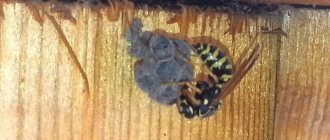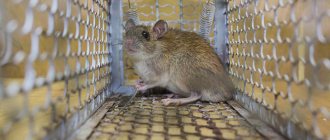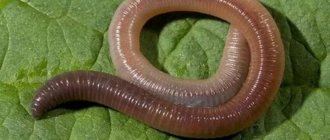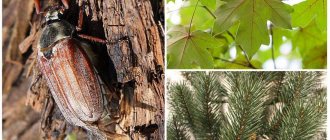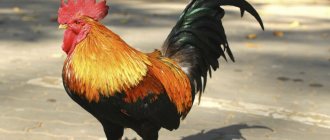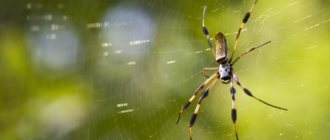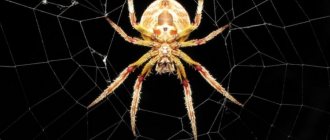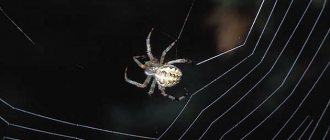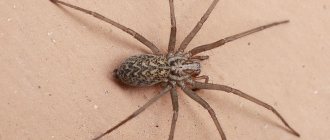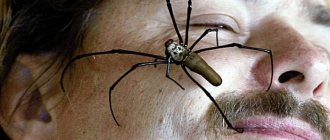We have all observed a situation when a fly, caught in a web, cannot get out of it, desperately twitches and becomes even more entangled in it. Meanwhile, the spider quickly runs towards its victim, not worrying at all about the sticky properties of the web.
How does this happen? Why does a fly stick tightly to the web, but the spider turns out to be invulnerable?
Surprisingly, this question was of interest not only to ordinary people and inquisitive children, but also to scientists. Since the beginning of the last century, they have been struggling with this riddle, and finally solved it.
There are several reasons for this phenomenon:
- not all threads in a web are sticky,
- Spiders have hairs on their legs and a special chemical
- Spiders move in a special way and carefully look after themselves.
What is a web and where does a spider get it from?
The abdominal cavity of the named insect contains up to 550 glands (microtubes) that produce future building material.
These spinning machines are ungrouped into 6 “warts”. This is a real mini adhesive rope factory. The nascent substance is a concentrated protein that quickly cools in air and hardens to the state of a thin thread that can withstand any gust of wind. The process already occurs inside each of the 6 warts - so the finished product flies out. The “hook-legged” one simply presses the warts to the point where he intends to start his weaving (as a rule, this is the corner of 3 planes). Warts are mobile - their functions resemble tentacles.
The structure will not crumble under the influence of a normal draft. The viscous substance is very similar in chemical composition to the tissue of silkworms. That is, the characteristics resemble silk. Only much more reliable and flexible. Caterpillar silk has a breaking load of 33-43 kilograms per 1 square meter. mm. And the product of a spider is from 40 to 261 kilograms per square meter. mm (here it all depends on the type of spider, and also on the location in which the designated “lace” is woven).
Where does a spider get its web in the form we are usually used to seeing it? That's another question.
RIDDLES OF THE WEB
Science and life // Illustrations
The adhesive substance covering the thread of the catching spiral is evenly distributed throughout the web in the form of bead droplets. The picture shows the place where two fragments of the catcher spiral are attached to the radius.
Science and life // Illustrations
Science and life // Illustrations
Science and life // Illustrations
Science and life // Illustrations
The initial stages of building a catching net by a cross spider.
The logarithmic spiral approximately describes the shape of the auxiliary spiral thread that the spider lays when constructing a wheel-shaped catching net.
The Archimedes spiral describes the shape of the adhesive trapping thread.
Zigzag threads are one of the features of the webs of spiders of the genus Argiope.
The crystalline regions of the silk fiber have a folded structure similar to the one shown in the figure. The individual chains are connected by hydrogen bonds.
Young cross spiders that have just emerged from their web cocoon.
Spiders of the family Dinopidae spinosa weave a web between their legs and then throw it over their prey.
The cross spider (Araneus diadematus) is known for its ability to weave large, wheel-shaped trapping webs.
Some types of spiders also attach a long “ladder” to the round trap, which significantly increases the efficiency of hunting.
Science and life // Illustrations
This is what the spider tubes from which the threads of spider silk emerge look like under a microscope.
‹
›
Spiders may not be the most attractive creatures, but their creation, the web, is nothing short of awe-inspiring. Remember how the geometric regularity of the finest threads shimmering in the sun, stretched between the branches of a bush or among tall grass, captivates the eye.
Spiders are one of the oldest inhabitants of our planet, inhabiting land more than 200 million years ago. There are about 35 thousand species of spiders in nature. These eight-legged creatures, which live everywhere, are recognizable always and everywhere, despite differences in color and size. But their most important distinguishing feature is their ability to produce spider silk, a natural fiber unsurpassed in strength.
Spiders use webs for a variety of purposes. They make cocoons for eggs from it, build shelters for wintering, use it as a “safety rope” when jumping, weave intricate trapping nets and wrap up caught prey. A female ready for mating produces a web thread marked with pheromones, thanks to which the male, moving along the thread, easily finds a partner. Young spiders of some species fly away from the parental nest on long threads carried by the wind.
Spiders feed mainly on insects. The hunting devices they use to get food come in a variety of shapes and types. Some spiders simply stretch out several signal threads near their shelter and, as soon as an insect touches the thread, they rush at it from ambush. Others throw a thread with a sticky drop at the end forward, like a kind of lasso. But the pinnacle of spiders’ design activity is still round wheel-shaped nets, located horizontally or vertically.
To build a wheel-shaped catching net, the cross spider, a common inhabitant of our forests and gardens, produces a fairly long, strong thread. A breeze or rising air flow lifts the thread upward, and, if the place for building the web is chosen well, it clings to the nearest branch or other support. The spider crawls along it to secure the end, sometimes laying another thread for strength. Then he releases a freely hanging thread and attaches a third to its middle, so that a Y-shaped structure is obtained - the first three radii out of more than fifty. When the radial threads and frame are ready, the spider returns to the center and begins to lay out a temporary auxiliary spiral - something like “scaffolding”. The auxiliary spiral holds the structure together and serves as a path for the spider when constructing a catching spiral. The entire main frame of the net, including the radii, is made of non-adhesive thread, but for the catcher spiral, a double thread coated with an adhesive substance is used.
What's surprising is that these two spirals have different geometric shapes. The temporary spiral has relatively few turns, and the distance between them increases with each turn. This happens because, when laying it, the spider moves at the same angle to the radii. The shape of the resulting broken line is close to the so-called logarithmic spiral.
The sticky trapping spiral is built according to a different principle. The spider starts at the edge and moves towards the center, keeping the same distance between the turns, creating an Archimedes spiral. At the same time, it bites off the threads of the auxiliary spiral.
Spider silk is produced by special glands located in the back of the spider's abdomen. There are at least seven types of arachnoid glands known to produce different threads, but no known spider species has all seven types at once. Usually a spider has from one to four pairs of these glands. Weaving a web is not a quick task, and it takes about half an hour to build a medium-sized trapping net. To switch to the production of a different type of web (for the catching spiral), the spider needs a minute's respite. Spiders often reuse webs by eating leftover webs that have been damaged by rain, wind, or insects. The web is digested in their body with the help of special enzymes.
The structure of spider silk has been perfectly developed over hundreds of millions of years of evolution. This natural material combines two wonderful properties - strength and elasticity. A web made of cobwebs can stop an insect flying at full speed. The thread from which spiders weave the base of their hunting web is thinner than a human hair, and its specific (that is, calculated per unit mass) tensile strength is higher than that of steel. If you compare spider thread with steel wire of the same diameter, they will support approximately the same weight. But spider silk is six times lighter, which means six times stronger.
Like human hair, sheep wool, and silk from silkworm cocoons, spider webs are composed primarily of proteins. In terms of amino acid composition, the proteins of the spider web - spidroins - are relatively close to fibroins, the proteins that make up the silk produced by silkworm caterpillars. Both contain unusually high amounts of the amino acids alanine (25%) and glycine (about 40%). Areas of protein molecules rich in alanine form crystalline regions densely packed into folds, providing high strength, and those areas where there is more glycine represent a more amorphous material that can stretch well and thereby impart elasticity to the thread.
How is such a thread formed? There is no complete and clear answer to this question yet. The process of web spinning has been studied in most detail using the example of the ampullaid gland of the orb-weaving spider Nephila clavipes. The ampullaid gland, which produces the strongest silk, consists of three main sections: a central sac, a very long curved canal, and a tube with an outlet. From the cells on the inner surface of the sac emerge small spherical droplets containing two types of spidroin protein molecules. This viscous solution flows into the tail of the sac, where other cells secrete another type of protein - glycoproteins. Thanks to glycoproteins, the resulting fiber acquires a liquid crystalline structure. Liquid crystals are remarkable in that, on the one hand, they have a high degree of order, and on the other, they retain fluidity. As the thick mass moves towards the outlet, the long protein molecules are oriented and aligned parallel to each other in the direction of the axis of the forming fiber. In this case, intermolecular hydrogen bonds are formed between them.
Humanity has copied many of nature's design discoveries, but such a complex process as spinning a web has not yet been reproduced. Scientists are now trying to solve this difficult problem using biotechnological techniques. The first step was to isolate the genes responsible for the production of the proteins that make up the web. These genes were introduced into the cells of bacteria and yeast (see Science and Life No. 2, 2001). Canadian geneticists have gone even further - they have bred genetically modified goats whose milk contains dissolved spider web proteins. But the problem is not only in obtaining spider silk protein, it is necessary to simulate the natural spinning process. But scientists have yet to learn this lesson from nature.
How does a spider weave its web?
The first portion of the released secretion is firmly glued to the selected location. Having thus fixed the beginning of the net being made, the insect gives another call to the system. The threads continue to stretch. How? The viscous substance is pushed through by the hind legs.
Before starting weaving, the spider chooses a place with a comfortable microclimate. It should be dry here, but not sunny. Cool, but not frosty. And, of course, there should be no wind.
When a multi-legged “micro-beast” leaves another location, the threads simply pull out after him (we have already said that they instantly harden in the open air). It moves in such a way that the network is a spiral composition intersected by radii. Where they converge is where the “start” was located. Sizes are usually different. Just like the nature of the spirals. In some places these are not even spirals, but circles of different diameters “inserted into each other.”
But in the forest, spiders build much larger “structures.” Have you noticed how in more often the sought-after “fetters” are stretched across the path? They are attached to tree trunks standing on opposite sides of the pole. Insects achieve this in this way. They produce a very long thread. Under the right circumstances, the breeze picks up the “rope”, mounting it on the branches of the nearest tree. And then it gets more interesting. Having walked to the middle of the “installation” (base) thread, the “multipede” weaves another one. This time hanging freely. Then the cunning man moves to its center, and, hanging vertically down, releases the next one. Until it reaches a nearby support. Using the method shown, a base for the frame is obtained. It's shaped like the letter Y. Now comes the most interesting part. “Tkach” connects the network intersection point with several more radius lines (more sticky). Until you get a lot of spirals. Different webs take different amounts of time - from 30 minutes to 2 hours.
It’s worth knowing that cross makers always have the same design for such a work – a spiral intersected by radii. But for any exotic spiders it can be anything. For example, the inhabitants of the Amazon weave several leaves into their masterpiece, creating decorations that attract flies.
Matthiola
(
Matthiola )
, or gillyflower - family of cruciferous plants
Name: named after Pietro Andrea Mattioli - a famous Italian botanist and doctor of the 16th century. Description: The genus includes more than 50 species, native to Central Europe, the Mediterranean and adjacent areas of Asia and Africa. One-, two- and perennial herbaceous plants, sometimes subshrubs. Stems are erect, 20–80 cm tall, branched, glabrous or tomentose. The leaves are oblong, lanceolate, entire or notched. The flowers are pink, white, purple or dirty yellow, collected in racemes or spike-shaped inflorescences. The fruit is a pod. The seeds are flat, narrow-winged, up to 700 pieces in 1 g. In former times, Levka could be seen in almost every garden, but now it is less common and has somehow gone out of fashion. Indeed, this plant has something old-fashioned, refined, belonging to the classic, regular, park style. And, if you feel nostalgia for noble and beautiful antiquity and a spicy, amazing, somehow sultry aroma, then gillyflower is your plant.
Mattiola two-horned - M. bicornis
(
Sibth. et Smith
)
DC.
Comes from Greece and Asia Minor. The plant is an annual erect or spreading, densely branched, 40–50 cm tall. The leaves are linear, coarsely toothed. The flowers are small, inconspicuous, greenish-lilac, in loose racemes, and have a very strong and pleasant aroma, especially in the evening and at night. During the day the flowers are closed. Blooms from June to August. The fruit is a long pod with two short horns at the top. The seeds are small, grayish-brown, and remain viable for 2–3 years. In culture since the 16th century.
Mattiola gray, or left-winged - M. incana (L.) R. Br.
Homeland - Mediterranean and Canary Islands. An annual herbaceous plant. The stems are simple or branched, often woody, from 20 to 80 cm tall. The leaves are oblong-lanceolate or narrow, obovate, tapering into a petiole, arranged in alternate order, obtuse, glabrous or pubescent, light or dark green. The flowers are regular, simple or double, of various colors, very fragrant, collected 10–60 in loose or dense, racemose inflorescences of various lengths and shapes. A simple flower has 4 sepals and 4 petals and blooms for 4–5 days; in terry - up to 70 petals, flowering lasts up to 20 days. Blooms profusely from June to November, in the south and during the winter months. The fruit is a narrow, multi-seeded pod, 4–8 cm long. Fruits well, seeds remain viable for 4–6 years. In culture since 1570.
According to the duration of the development cycle, three forms are distinguished: autumn leaves (var. autumnalis), sown in March-April, blooms in late summer - early autumn; the seeds ripen the next year; winter gillyflower (var. hibema), sown in June-July, blooms the following spring. Both forms do not overwinter in the open ground of the middle zone and are used mainly for forcing. The most widespread and important is the summer gillyflower (var. annua). Currently, about 600 varieties are known, differing in the shape and height of the bush, flowering time and variety of flower colors. Only plants with double flowers have decorative value. Double flowers never produce seeds. Seeds are produced on plants with simple flowers. Typically, in crops, some plants develop with simple flowers, and some with double flowers. The best varieties have up to 70-90% of plants with double flowers. To obtain a larger percentage of plants with double flowers in the offspring, it is necessary to select the seed plants, taking into account some morphological characteristics. Plant bushes that produce double flowers in their offspring have a more depressed appearance and short pods with a rounded top, with stigma lobes pressed against each other. Plants that produce only simple flowers have more pods, their stigma blades are bent and form “horns” at the end of the pod. According to their height, summer gillyflower varieties are divided into three groups: low - 15-30 cm high; medium - 30-50 cm; tall - 50-70 cm. Based on the shape of the inflorescences, they are divided into eight groups: I. Bouquet (Victoria). — Plants are 25-35 cm tall, branched, compact. The leaves are large, elongated oval, entire, bluish-green. The main and lateral inflorescences are located almost at the same level, dense or medium-dense. The flowers are densely double, 3-3.5 cm in diameter. Medium early varieties. They bloom from June for 50-75 days. Recommended for flower beds, ridges, potting, cutting. II. Gigantic bomb-shaped ones. — Plants are densely leafy with a wide pyramidal bush shape, 45-60 cm tall. The leaves are large, elongated rhombic, rarely notched, grayish-green. The main inflorescence is large, 15-25 cm long, loose, and blooms before the side ones. The flowers are densely double, 4-4.5 cm in diameter. Late varieties. They bloom from July for 45-50 days. Recommended for cutting and flower beds. III. Quedlinburg (all terry). — In varieties of this group, plants with double flowers are easily distinguishable in the cotyledon state by their light green color. Plants with single flowers have a regular, gray-green color. The varieties of this group are divided into subgroups according to flowering time and habit: a) late tall bushy. — Plants are 50-60 cm tall, highly branched bushes, wide-pyramidal in shape. The leaves are elongated, narrowly obovate, obtuse or lanceolate, entire or unequally toothed, green. The flowers are densely double, 4-5 cm in diameter. Inflorescences are 20-50 cm long. Late varieties. They bloom from July for 40-50 days. b) early tall bushy. — Plants are 45-65 cm tall, spreading bushes, branched, with a wide pyramidal shape. The leaves are lanceolate to obovate, with a smooth or wavy edge, bluish-green, very large. Inflorescences are 13-20 cm long. The flowers are bright, pure colors, 4-5 cm in diameter. Blooms from June 55-60 days. c) early low bushy. — Plants are 25-40 cm tall, compact or semi-spreading bushes, highly branched, spherical in shape. The leaves are elongated oval and lanceolate, bluish-green. Inflorescences are 12-20 cm long. The flowers are double, up to 4-4.5 cm in diameter. They bloom from June for 40-65 days. d) pole-shaped. — Bushes are single-stemmed or weakly branched, pyramidal in shape, 50-80 cm tall. The leaves are oblong, narrowly obovate, obtuse. Inflorescences are loose, 20-60 cm long. The flowers are densely double, very large, 4-6 cm in diameter. The central inflorescence rises above the lateral ones. Early varieties. They bloom from June for 35-55 days. Recommended for cutting. IV. Korotkovistye (Erfurt). — Plants are 30-40 cm tall, highly branched bushes, compact, leafy, wide-pyramidal in shape. They differ from other groups in having higher lateral shoots. The leaves are large, elongated oval, entire, bluish-green. The flowers are 3-4 cm in diameter, convex. The central inflorescence rises above the lateral ones. Blooms from June 35-60 days. Used in flower beds, as a potted crop, and as cut flowers.
V. Large-flowered gigantic tree-like. — Plants up to 90 cm tall, branching at the top. The flowers are large, 4-6 cm in diameter, densely double, collected in large, compact inflorescences of various bright colors. The leaves are large, elongated-oval, with a wavy edge. They bloom from June for 45-60 days. Recommended for group plantings, borders and cuttings. VI. Single-stem (zksielzior). — Single-stem plants 50-80 cm tall with large, densely double flowers up to 5-6 cm in diameter, collected in powerful compact inflorescences. The leaves are large, diamond-shaped, with curling or wavy edges. They bloom from June for 25-30 days. Recommended for cutting. VII. Pyramidal. — This group is divided into subgroups according to plant height: a) gigantic large-flowered. - Plants are semi-tall - 40-50 cm, and tall - 50-80 cm tall, pyramidal in shape. The flowers are large, 4-5 cm in diameter, densely double. The leaves are elongated-oval with a blunt, rounded tip, slightly concavate. Medium early varieties. They bloom very luxuriantly from June to September. b) dwarf. — Plants are 20-25 cm tall, branched, pyramidal, with compact inflorescences. The flowers are large, 4-4.5 cm in diameter. The leaves are oval-elongated, entire, bluish-green, dark green or shiny, large. The earliest varieties. They bloom from June for 40-50 days. c) semi-high. — Plants are 30-45 cm tall, branched, with highly developed shoots, pyramidal in shape. Inflorescences are 13-18 cm long, compact. Flowers are 3-4.5 cm in diameter. The leaves are elongated-oval, narrow. Medium early varieties. They bloom from June for 45-60 days. VIII. Spreading. — This group is divided into two subgroups: a) remontant (Dresden). — Plants are 50-60 cm tall, highly branched, bush-like. Inflorescences are loose. The flowers are large, 3.5-5 cm in diameter. The leaves are elongated-oval, entire or notched, bluish-green. They bloom from June - July to November. b) large-flowered late (bismarck). — The plant is bush-shaped, with a powerful branched stem, 45-70 cm tall. Inflorescences are loose. The flowers are very large, 4.5-5.5 cm in diameter, densely double. The leaves are large, elongated oval, entire. Late varieties. They bloom from July until frost. Numerous varieties of summer gillyflower within each group differ in color, size of flowers and inflorescences.
Location: Levkoy grows well in various soil and climatic conditions with sufficient soil and air moisture. It achieves its greatest decorative effect in open, sunny places. Does not tolerate stagnant water and prolonged drought. Soil: prefers fertile, non-acidic, soddy-loamy or soddy-sandy loam soil. Organic fertilizers cannot be applied during the planting year. Care: Levkoi are grown with constant feeding and watering in dry weather. Since double gillyflower plants do not produce pods, the flowers that bloom from below are picked only to preserve the fresh appearance of the plant. If you leave them, the flowering will not stop. Levkoy should not be planted in a place where other cruciferous plants were grown. They can be affected by cruciferous clubroot, a fungal disease that affects cabbages and other plants of this family. It must be borne in mind that the clubroot pathogen retains the ability to infect plants for many years. In addition to clubroot, levy can be affected by all other pests and diseases, including cruciferous flea beetles, cabbage butterflies, white butterflies, and so on. Reproduction: for June flowering, seeds are sown in mid-March in boxes with a mixture of turf soil and sand in a ratio of 3:1. When seedlings appear, the temperature in the greenhouse is reduced to 8-12°C, and the boxes are placed closer to the light. After 10-12 days, at the cotyledon stage, the seedlings are planted in nutrient cubes or pots and after some time taken out into greenhouses. For picking, use a mixture of turf, leaf soil and sand in a ratio of 2:2:1. Hardened gillyflower seedlings can easily tolerate temperatures down to -5°C; they can be planted in the ground in a permanent place earlier, maintaining a planting distance of 20-25 cm. To ensure continuity of gillyflower flowering throughout the summer, repeat sowings are carried out every 10-15 days.
Levkoy is a very interesting, one might say, unique plant. Despite the fact that the doubleness of its flowers is complete or absolute, that is, all the stamens and pistil have turned into petals, and plants with double flowers do not produce seeds at all, gillyflower is propagated by seeds. These seeds are collected from plants that have simple four-petal flowers and do not represent any decorative value. And in the seed progeny of these plants, splitting occurs into plants with simple and double flowers, most often in a 1:1 ratio. However, plants with simple flowers (they are called seed plants) are also heterogeneous in terms of doubleness. Practice has established that underdeveloped plants with short and blunt-pointed pods pressed to the stem produce a higher percentage of double plants than seed plants with other characteristics. And now there are varieties containing 60, 80 and even 90% terry plants. In addition, now most garden groups have a signal characteristic by which plants with future double flowers can be separated from seedlings in the cotyledon leaf phase. Levkoy crops of these groups are kept at a temperature of 12-15°C, the emerging shoots are placed for several days in an even cooler place with a temperature of 6-8°C. The cotyledonous leaves of plants with double flowers will be larger and pale green, in contrast to the bright green ones with simple ones. This makes it possible to select 100% of terry plants for planting. Use: the main advantage of matthiola is its enchanting aroma, which intensifies in the evening. For this reason, matthiola bicornuum is called night violet. Since ancient times, matthiola has been planted near benches, gazebos, and terraces. It is grown in mixed flower beds and is sometimes used in Moorish lawns. Good for bouquets. Levka grey-haired can be planted in flower beds and ridges, combining varieties according to plant height and flower color, as well as flowering time. Levka can be planted in containers, outdoor vases and balcony boxes. Tall varieties are good for cutting inflorescences. They stand in water for up to 10 days, filling the room with aroma. Source:
- flower.onego.ru - encyclopedia of ornamental garden plants.
Additional Information:
- bezlji.com - Levkoy (matthiola), cultivation;
- medn.ru - Levkoy, cultivation and care;
- gardenia.ru - gray-haired summer lefty: growing in the garden and in a container;
- tagetes.rf - cultivation of left grass;
- bankreceptov.ru - Levka, varieties, growing in a greenhouse, greenhouse.
Purpose of the web
You already know how a spider makes its web. But why does she need a topic? For several purposes at once.
- Here the insect takes refuge from any enemy or from bad weather (it entwines a hole with a net).
- From the web, the creature makes nets to catch small flying creatures (flies, etc.).
- Cocoons for protecting eggs (their “cases”) are also made from durable “silk”.
- The web “mat” insures its owner at the moment of a long jump - the spider does not fall.
- The product is used as a container - in it the hunter sometimes drags large prey into a hole.
- A cradle for baby spiders is another purpose for a masterpiece of spinning craftsmanship.
- The cubs, ready for independent life, are sent along “ropes” to different corners.
- The adhesive substance prevents tarantulas from slipping.
- Sperm transfer.
It remains to add: for catching nets, a more sticky composition of the cobweb substance is used. Although not only the described insects, but all arachnids can prepare webs, only spiders secrete so much sticky substance that they can cover an entire small room with it.
Differences in webs by spider species
Depending on the species, spiders can weave different webs, which are a kind of “calling card” of the arthropod.
Round web
This version of the web looks incredibly beautiful, but is a deadly design. As a rule, a round web is suspended in a vertical position and has part of the adhesive threads, which does not allow the insect to escape from it. Weaving such a network is carried out in a certain sequence. At the first stage, the outer frame is made, after which radial fibers are laid from the central part to the edges. Spiral threads are woven at the very end.
This is interesting! A medium-sized circular web has more than a thousand point connections, and its production requires more than twenty meters of spider silk, which makes the structure not only very light, but also incredibly durable.
Information about the presence of prey in such a trap comes to the “hunter” through specially woven signal threads. The appearance of any breaks in such a web forces the spider to weave a new web. Old webs tend to be eaten by arthropods .
Strong web
This type of web is characteristic of nephilous spiders, which are widespread in Southeast Asia. The trapping nets they build often reach a couple of meters in diameter, and their strength allows them to easily support the weight of an adult.
Such spiders catch in their strong web not only ordinary insects, but also some small birds. Research results show that spiders of this type can produce about three hundred meters of spider silk daily.
Spider web hammock
Small, round “coin spiders” weave one of the most complex web designs. These arthropods weave flat webs on which the spider sits and waits for its prey. Special vertical threads extend up and down from the main network, which are attached to nearby vegetation . Any flying insects quickly become entangled in the vertically woven threads, after which they fall onto the flat hammock web.
Why doesn't the spider stick to the web?
If the substance described is so sticky, then why doesn’t its creator himself stick to the creation?
One important fact has already been mentioned. Threads are produced in 2 categories at once - dry (not sticky) and viscous (sticky). The creator of the web moves precisely along the first ones. Just like his offspring.
And if we are talking about the construction of the network itself (during the process all the threads must be glued together), then everything is clear here too. The spider secretes glue on its special legs. He smears it on the section of thread he walked over. The spider remembers everything.
Moreover, a substance is also released that, during movement, reduces the adhesion of the adhesive type of legs to the thread. To prevent these special legs from sticking to one of them.
Thus, it is clear that the spider is a combination consisting of three types of secretion at once. Different pairs of legs work with the glands. Some processes destroy an object in order to make a hole (the spider drags the victim there). The processes presented are controlled by the nerve center.
Reason one - not all threads in the web are sticky
Spiders spin different threads for different purposes . Some are for unhindered movement along the web, others are for catching and entangling insects, and still others are for weaving egg sacs. There are up to 6 different types of threads that spiders can weave.
The center of the web is woven from dry, safe threads. There the spider rests and patiently waits for its dinner. The radial threads running from the center to the edge and the outer circumference of the web itself are also made of dry threads. These are the paths along which the spider moves. But the circular threads are just sticky . They are the ones who hold the victim in a stranglehold and do not allow her to escape.
There are also webs where there are no completely sticky threads, they are simply dotted with small sticky droplets. The result is the same - the insect touches them and gets stuck, and the spider knows where to step and where not to.
How is a web weaved?
The basis of each spider trap is 3-4 load-bearing threads. This is the strongest part of the web. Radial threads are attached to the base, each end of which is attached to a support in the form of a tree branch, plant leaves, and so on. The spider applies a trapping spiral to the radial threads, which is the stickiest part of the trap. It is precisely this that spiders fall prey to—to prevent the prey from freeing itself, the predator quickly runs to it and injects poison. These substances transform the insides of insects caught in the web into a nutrient mass, which the spiders simply absorb into themselves.
The structure of the web
Composition of the web
The basis of the web (2/3 of its composition) is the water-insoluble protein fibroin (fibrillar protein). This is a substance that gives spider webs increased strength. It consists of a complex of simple proteins (albumin), d-alanine (amino acid), glutamic and aminoacetic acids.
The stickiness of the web is provided by sericin (a substance of protein origin, silk glue). The chemical composition of the web also includes potassium nitrate and hydrogen phosphate, which provide protection against bacteria and fungi.
Depending on the type of glands used, the spider produces about 7 types of fibers of different chemical compositions, from which it weaves the structural parts of the web.
The structure of the thread is heterogeneous. It is composed of rigid protein crystals firmly connected by elastic ligaments. In terms of its chemical composition and properties, the web is similar to silkworm silk, but spider silk is stronger.
The thread retains tensile strength and does not twist even with prolonged rotation. The last property is called “hinge”. Sunlight, hot and dry air weaken the strength of the thread.
